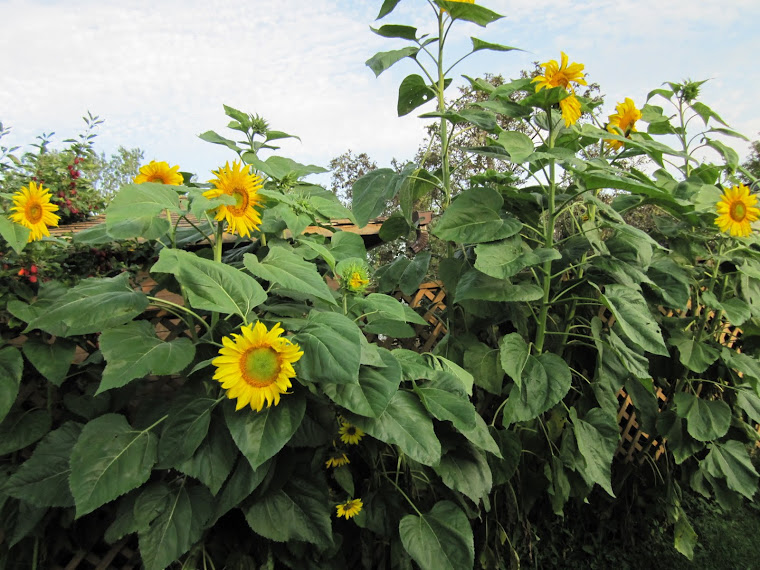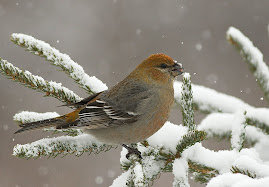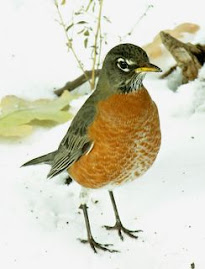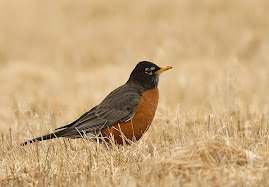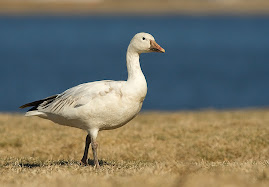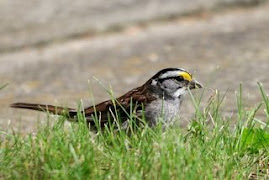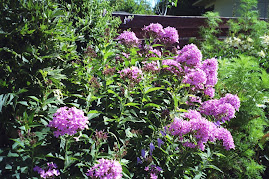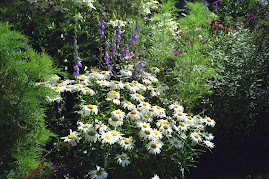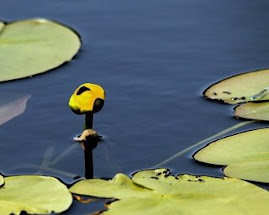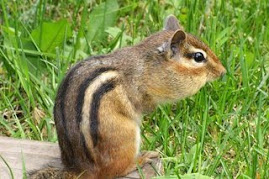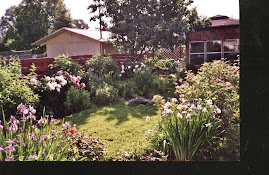I am running out of lights and tables too. As mentioned before, I put the seedlings under regular shop lights set on tables. I use a couple of bricks at each end to hold up the light. The plants are very close to the florescent tubes but as they grow, I gradually raise the lights, first by turning one brick on its side and then turning both bricks.
Each shop light fixture contains one cool florescent tube and one gro-light tube.
Right now I have the following under lights. Vegetables: cucumber, squash, zucchini. Herbs: basil, dill, marjoram, rosemary, oregano, cilantro and parsley. Flowering annuals: nicotania, canary vine, dwarf marigolds, impatience, lobelia, lavatera, geranium, evening stock, schizanthus, godetia, cosmos, bachelor buttons, dianthus. Keen readers will note the absence of the wave petunias – they did NOT germinate nor did the hibiscus. Two flops.
Some of this stuff grows quickly but others poke along.
Now I must place a few flats sideways. I lift one light fixture three bricks high and put four flats of the tallest plants under sideways and use a foil space blanket thrown over the light fixture to help spread the light. Not the best solution but it is too cold to put the biggest plants in the garden shed. It is way too cold (snowing as I write this) to put anything outside, even close to the house.
At this time of year, the flats are bushy and thirsty, very thirsty. I am spending more time watering. I only water where I see dried soil. As noted before I put one drop of Damp-off in the watering can and I also put a tiny bit of fertilizer powder, the stuff special for seedlings. I buy Plant Prod water soluable starter fertilizer (10-52-10) for this purpose. One large container lasts a long time, years in fact. Pretty soon, I’ll switch to 20-20-20 powder, also by Plant-Pro. In the garden itself, I use chicken manure tea, brewed up in an old garbage can. More on this later.
Showing posts with label Grow lights. Show all posts
Showing posts with label Grow lights. Show all posts
Monday, 28 April 2008
Saturday, 9 February 2008
Gardening in February
The Lindenburg Seeds catalogue has arrived. This nursery in Brandon Manitoba has been in operation for 73 years. I know several people who swear by their products, especially their excellent vegetable seed selection.
At this time of year, I am on the prowl for bargains in fluorescent grow-lights or full spectrum tubes. I put one cool tube and one warm or grow tube in each florescent light fixture. This method has worked well for many years. The cool tubes are cheap and, if bought in quantity, you can get them for about a dollar each. But the grow lights are much more expensive. Around town, prices vary between $4.99 to $7.99.
I use the standard 4 foot florescent shop light fixtures and set them up on bricks on long tables or on boards set between tables. I set up in my basement. I have thirteen light fixtures so by April, the entire basement looks like a grow-op.
Another February task is to put the indoor start dates for each type of seed on a wall calendar so I can see at a glance when each must be planted. Each cultivar has its own timetable and growing method. Sometimes, it is not easy to get the information you need. Some catalogues merely state, “start seed inside,” a phrase that tells you nothing. You want to know the date to start, the preferred method to use to germinate, the depth to plant the seed, whether you germinate in light or dark conditions, cool or warm.
The germination information is crucial. Once you get the seed germinated you have passed the biggest hurdle. Some plants, such as primrose and schizanthus, need just the right conditions or they just won’t germinate. Pansies are tricky too.
Annoyingly, some seed companies give very little information on their pack or use the same information for every type of seed.
I have kept careful record of planting and germination info for the past twelve years. These are the dates that work for me, in my warm basement or cool porch. I have often found that the start date as given in the catalogue or the seed packet does not work for me. Sometimes May has arrived and the plants are too small to set out in the garden. Worse, much worse, the plants are too leggy and stretched in spite of pinching them back. They can be saved by burying the stretched stalks, but it is nerve racking just the same.
The best place for indoor growing information is the Stokes Catalogue. Stokes, plus the info on the seed packet, and above all my own records, allow me to make a best guess of the start date for each type of seed.
Some examples of my notes. Lobelia – Crystal Palace blue. Sow 10 – 12 weeks before planting or March 10. Germinate warm and then reduce heat Lobelia is slow to flower. Seeds are very fine - try to sow as thinly as possible. Do not cover - needs 80!! Warm water. Put on top of fridge or on counter under light all day. Should germinate in 5 - 10 days. Transplant in small clumps - 4 -5 seedlings per clump - They do not like too much peat moss in the soil mix. This transplanting will take place 3 - 4 weeks after seeding. If they start to bloom indoors shade the blooms. Outside, lobelia likes partial shade and lots of water. Does very well in my large shallow pots. A big hit of blue.
You can see here some of the problems. It is difficult to find a place that is 80 degrees in a small suburban house. I could put them under florescent lights but these lights do not give out much heat. I have a large thermometer and try to find the warmest place possible. That is really all an amateur grower can so. Nevertheless I always have success with lobelia and I grow a lot of it.
At this time of year, I am on the prowl for bargains in fluorescent grow-lights or full spectrum tubes. I put one cool tube and one warm or grow tube in each florescent light fixture. This method has worked well for many years. The cool tubes are cheap and, if bought in quantity, you can get them for about a dollar each. But the grow lights are much more expensive. Around town, prices vary between $4.99 to $7.99.
I use the standard 4 foot florescent shop light fixtures and set them up on bricks on long tables or on boards set between tables. I set up in my basement. I have thirteen light fixtures so by April, the entire basement looks like a grow-op.
Another February task is to put the indoor start dates for each type of seed on a wall calendar so I can see at a glance when each must be planted. Each cultivar has its own timetable and growing method. Sometimes, it is not easy to get the information you need. Some catalogues merely state, “start seed inside,” a phrase that tells you nothing. You want to know the date to start, the preferred method to use to germinate, the depth to plant the seed, whether you germinate in light or dark conditions, cool or warm.
The germination information is crucial. Once you get the seed germinated you have passed the biggest hurdle. Some plants, such as primrose and schizanthus, need just the right conditions or they just won’t germinate. Pansies are tricky too.
Annoyingly, some seed companies give very little information on their pack or use the same information for every type of seed.
I have kept careful record of planting and germination info for the past twelve years. These are the dates that work for me, in my warm basement or cool porch. I have often found that the start date as given in the catalogue or the seed packet does not work for me. Sometimes May has arrived and the plants are too small to set out in the garden. Worse, much worse, the plants are too leggy and stretched in spite of pinching them back. They can be saved by burying the stretched stalks, but it is nerve racking just the same.
The best place for indoor growing information is the Stokes Catalogue. Stokes, plus the info on the seed packet, and above all my own records, allow me to make a best guess of the start date for each type of seed.
Some examples of my notes. Lobelia – Crystal Palace blue. Sow 10 – 12 weeks before planting or March 10. Germinate warm and then reduce heat Lobelia is slow to flower. Seeds are very fine - try to sow as thinly as possible. Do not cover - needs 80!! Warm water. Put on top of fridge or on counter under light all day. Should germinate in 5 - 10 days. Transplant in small clumps - 4 -5 seedlings per clump - They do not like too much peat moss in the soil mix. This transplanting will take place 3 - 4 weeks after seeding. If they start to bloom indoors shade the blooms. Outside, lobelia likes partial shade and lots of water. Does very well in my large shallow pots. A big hit of blue.
You can see here some of the problems. It is difficult to find a place that is 80 degrees in a small suburban house. I could put them under florescent lights but these lights do not give out much heat. I have a large thermometer and try to find the warmest place possible. That is really all an amateur grower can so. Nevertheless I always have success with lobelia and I grow a lot of it.
Subscribe to:
Posts (Atom)

